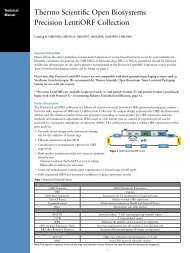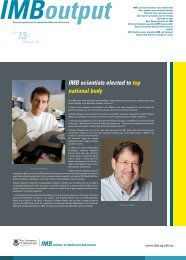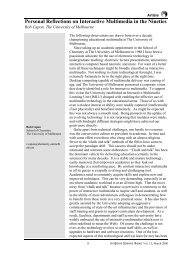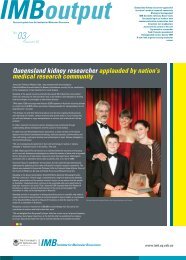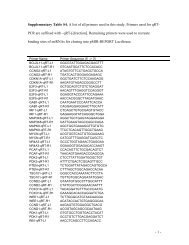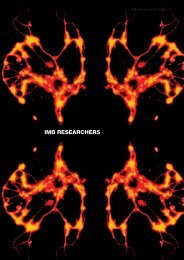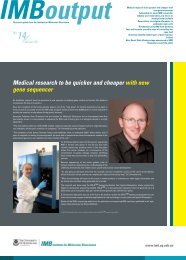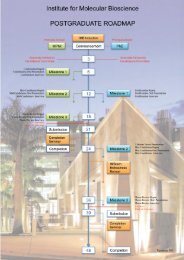2010 Annual Report - Institute for Molecular Bioscience - University ...
2010 Annual Report - Institute for Molecular Bioscience - University ...
2010 Annual Report - Institute for Molecular Bioscience - University ...
You also want an ePaper? Increase the reach of your titles
YUMPU automatically turns print PDFs into web optimized ePapers that Google loves.
63 imb researchers: joint appointments<br />
ALAN E. MARK<br />
MOLECULAR DYNAMICS OF BIOMOLECULAR<br />
SYSTEMS<br />
surface receptors. In particular, we are<br />
investigating how the binding of human<br />
growth hormone to the extra-cellular<br />
growth hormone receptor is coupled to<br />
structural changes within the cell. We are<br />
also investigating the mechanism by which<br />
the E or envelope proteins of the Dengue<br />
and Ebola viruses facilitate the entry of<br />
these viruses into cells.<br />
THE GROUP CONCENTRATES ON<br />
modelling the structural and dynamic<br />
properties of biopolymers such as proteins,<br />
nucleic acids and lipid aggregates. In<br />
particular, we use computer simulations to<br />
understand and predict the macroscopic<br />
(experimentally observable) behaviour of<br />
complex biomolecular systems based<br />
on the interactions between atoms. We<br />
develop the software, atomic <strong>for</strong>ce fields<br />
and theoretical models needed to address<br />
a range of fundamental questions.<br />
First, how do proteins fold Understanding<br />
how proteins fold is one of the grand<br />
challenges of modern biology and a critical<br />
test of our ability to accurately predict<br />
interactions in protein systems. The failure<br />
of proteins to fold correctly is also linked to<br />
a range of debilitative diseases including<br />
Alzheimer’s Disease, BSE and some<br />
<strong>for</strong>ms of Type II diabetes where misfolded<br />
proteins <strong>for</strong>m destructive aggregates<br />
called amyloid fibrils. Dramatic progress<br />
is being made in the de novo folding of<br />
small peptides and the refinement of larger<br />
proteins. Research on folding is conducted<br />
at multiple levels. Small model systems are<br />
used to refine <strong>for</strong>ce fields and simulation<br />
techniques. On a larger scale we are<br />
simulating how multiple copies of certain<br />
peptides aggregate in order to understand<br />
how amyloid fibrils <strong>for</strong>m.<br />
Second, how do cell surface receptors<br />
transmit a signal through the cell<br />
membrane Receptor proteins on the<br />
surface of cells play a vital role in cellular<br />
communication. However, little is known<br />
in regard to the mechanism by which the<br />
binding of a molecule to an extracellular<br />
receptor transfers a signal across the<br />
cell membrane or even how changes in<br />
the environment can activate certain cell<br />
Third, how do membrane-protein<br />
complexes assemble Cell membranes<br />
are the archetypal self-organised<br />
supramolecular structure. In addition to<br />
being of critical importance in structural<br />
biology, membrane-protein complexes<br />
are also prime therapeutic targets. Using<br />
simulations, we are investigating the<br />
assembly of functional structures such as<br />
the assembly of anti-microbial peptides<br />
into transmembrane pores. This is being<br />
used to understand the mechanism<br />
by which larger complexes <strong>for</strong>m in<br />
heterogeneous environments as well as to<br />
understand in detail how smaller antibiotics<br />
such as vancomycin recognise membrane<br />
targets.<br />
RESEARCH PROJECTS<br />
• Peptide folding and assembly<br />
• Mechanism of action of antimicrobial<br />
peptides.<br />
• The nucleation and growth of amyloid<br />
fibrils<br />
• Mechanism of activation of type 1<br />
cytokine receptors<br />
KEY PUBLICATIONS<br />
Malde, A., and Mark, A.E. (<strong>2010</strong>).<br />
Challenges in the determination of the<br />
binding modes of non-standard ligands<br />
in X-ray crystal complexes. Journal of<br />
Computer-Aided Moecular Design 25:<br />
1-12.<br />
Poger, D., and Mark, A. E. (<strong>2010</strong>). Turning<br />
the growth hormone receptor on: Direct<br />
evidence that hormone binding induces<br />
subunit rotation. Proteins: Structure,<br />
Function, and Bioin<strong>for</strong>matics. 7: 1163-<br />
1174.<br />
Periole, X., Rampioni, A., Vendruscolo,<br />
M., and Mark, A.E. (2009). Factors that<br />
affect the degree of twist in b-sheet<br />
structures: A molecular dynamics<br />
simulation study of a cross-ß filament<br />
of the GNNQQNY peptide. Journal of<br />
Physical Chemistry B 113: 1728-1737.<br />
The interaction of the peptide D-ala-D-ala<br />
(solid representation) with the antibiotic<br />
vancomycin. The red spheres indicate the<br />
distribution of structural waters observed<br />
during the simulations.<br />
Rotation of the extracellular domains of<br />
the growth hormone receptor associated<br />
with activation by growth hormone. A<br />
superposition of the hormone free <strong>for</strong>m<br />
obtained from the simulations (green and<br />
red) on to the hormone bound (activated)<br />
con<strong>for</strong>mation (yellow)<br />
Yesylevskyy, S., Marrink, S.J., and Mark,<br />
A. E. (2009). Alternative mechanisms<br />
<strong>for</strong> the interaction of the cell-penetrating<br />
peptides Penetratin and the TAT peptide<br />
with lipid bilayers. Biophysical Journal 97:<br />
40-49.<br />
van Gunsteren, W.F., Dolenc, J., and<br />
Mark, A.E. (2008). <strong>Molecular</strong> simulation<br />
as an aid to experimentalists. Current<br />
Opinion in Structural Biology 18: 149-153.<br />
LAB MEMBERS<br />
Research Officers: Dr David Poger, Dr<br />
Alpesh Malde, Dr Megan O’Mara, Dr<br />
Mortiz Wigner<br />
PhD Students: Daniela Mueller, Ying Xue,<br />
Rong Chen, Pramod Nair, Zhi Guang Jia




